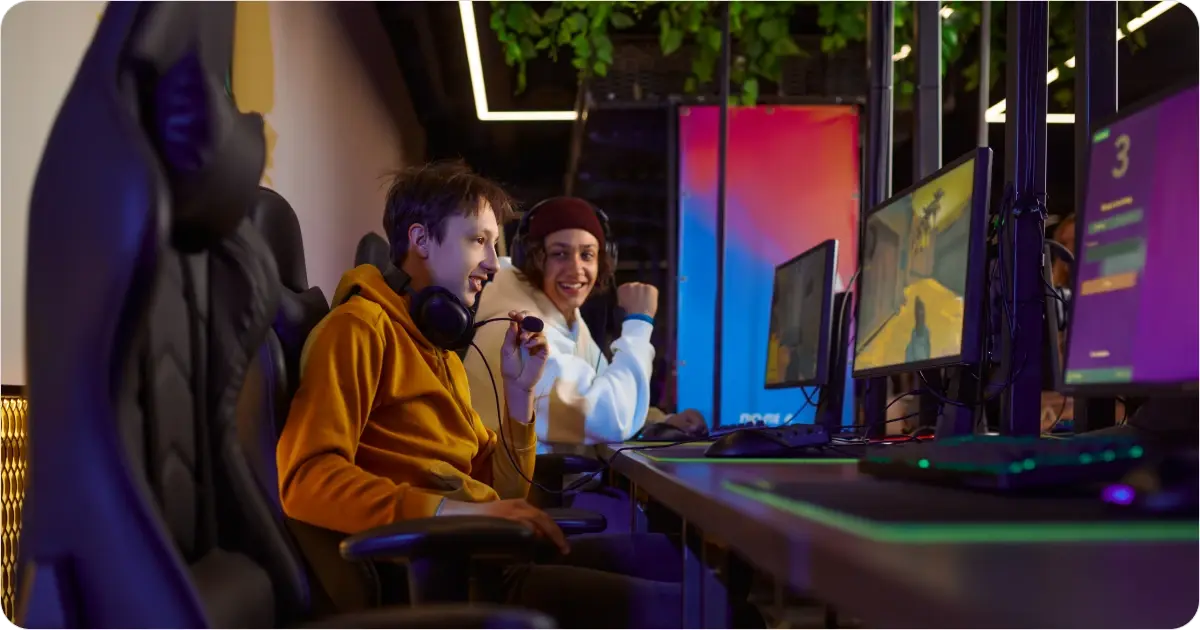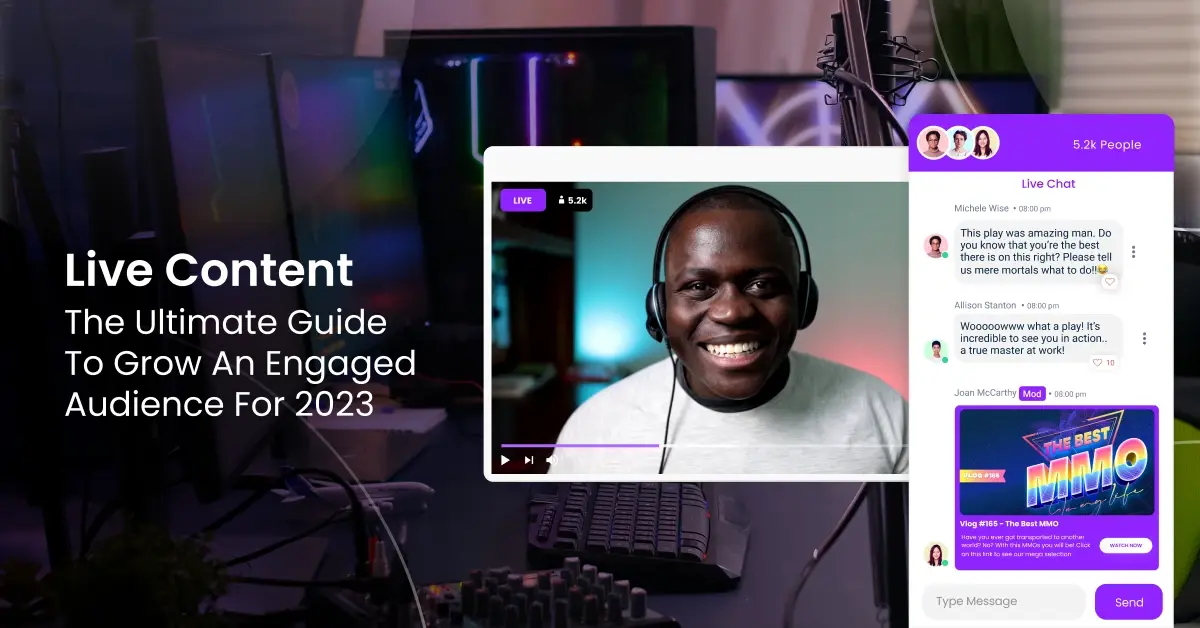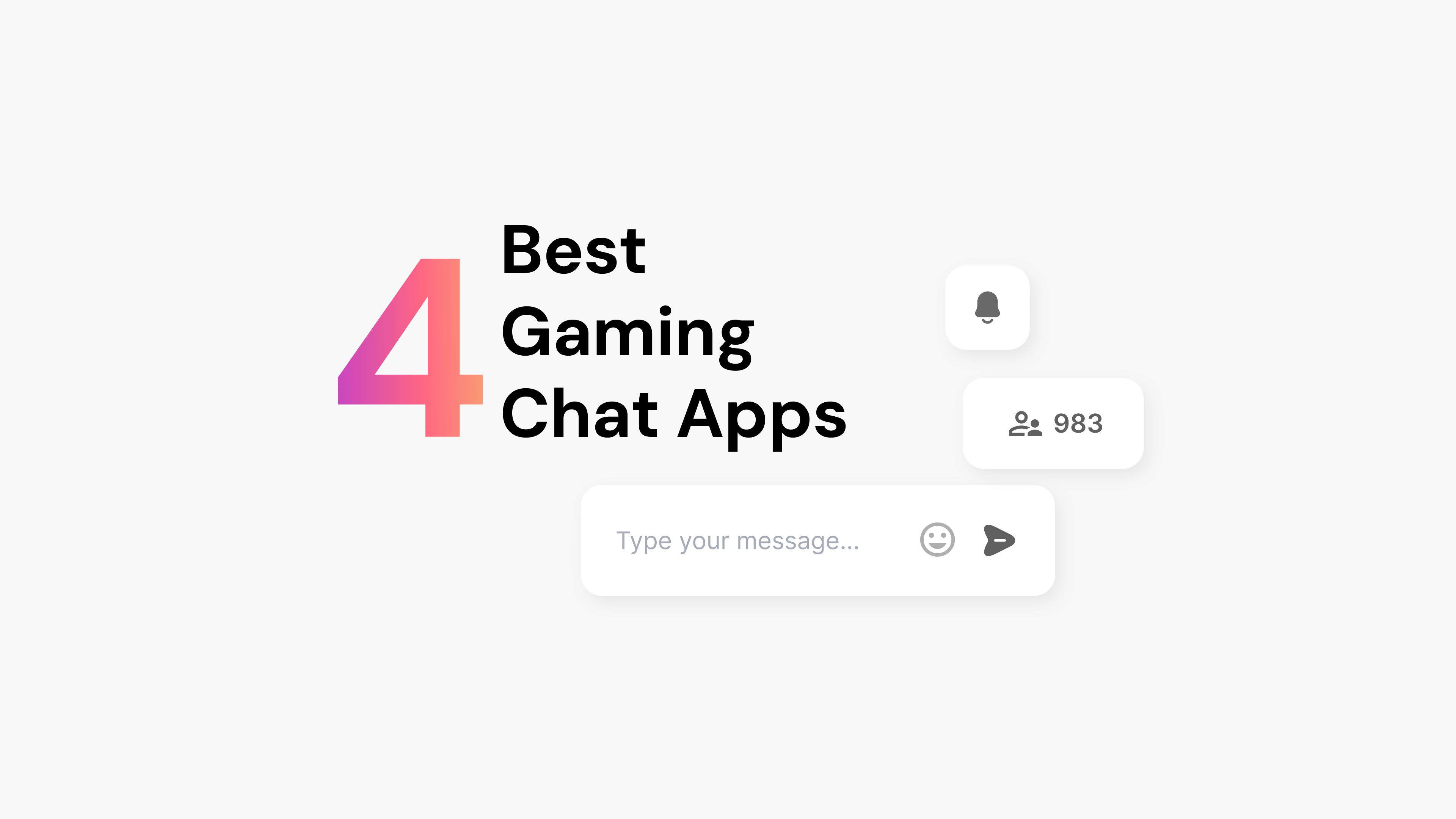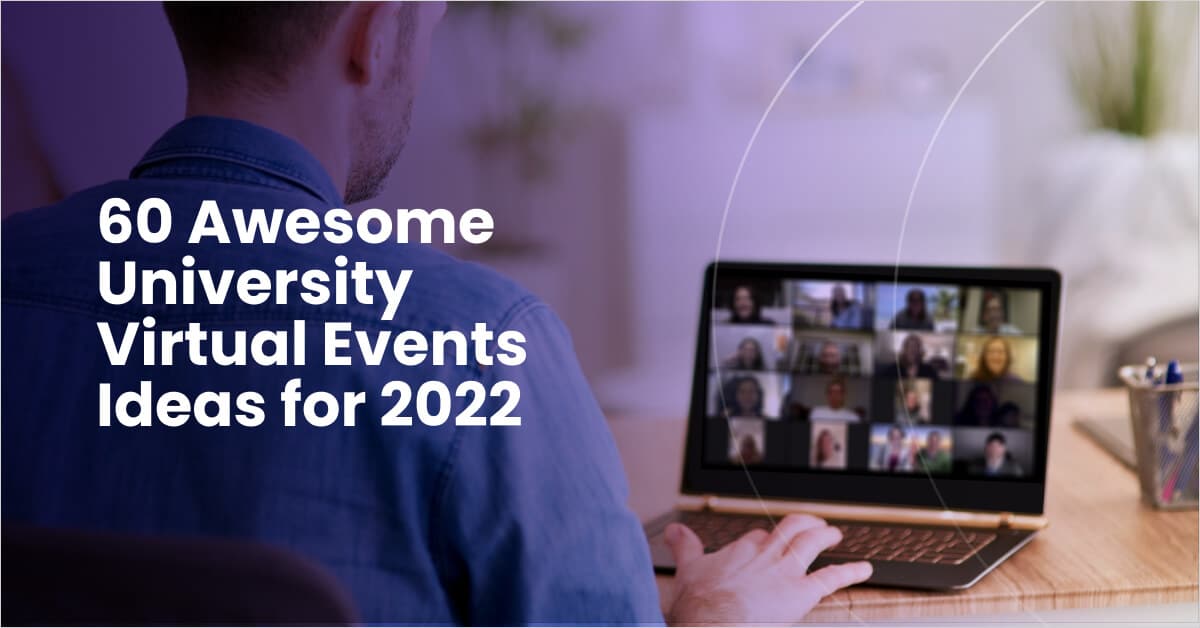




Live content is booming in popularity. Video-sharing services, generative AI, and high-speed networks make it easier than ever to share live content.
Also known as live streaming, live content is a powerful way to increase engagement and achieve your revenue goals.
This guide covers everything you need about live content, including best practices to get up and running fast.
Live Content By The Numbers

The following stats should exactly how popular live content and online video are booming in popularity.
- Nearly half (44%) of live-streaming video viewers watch less live TV as a result (source)
- The top 3 most popular types of live content are: live news, live content on social media, and live awards shows (source)
- More than 75% of US households subscribe to a streaming service (source)
- There are over 25,000 full-time YouTube content creators active today (source)
- Twitch, a streaming content platform focused on gaming, has more than two million regular viewers (source)
Live content is much more than entertainment, by the way. A growing number of companies are leveraging live streaming to sell products. Known as live commerce or live shopping, this type of business video is a powerful way to present products and generate leads at scale.
What is Live Content?
Live content means sharing a live video broadcast to your followers online. Content creators and companies often share videos on social platforms like YouTube, Facebook, and Twitch. After the video broadcast, the video content may be available online in some cases.
Three Reasons Audiences Love Live Content
Participating in a live content experience appeals to people for a few reasons.
Live content is a powerful way to deepen your brand’s connection with your audience. For example, a publisher can offer participants to interact with their best-known personalities and columnists.
Interacting with a celebrity is fun, but that’s just part of the value of live content. Your audience also has the chance to meet other people who share their interests.
A live content experience is a one-time experience. You can leverage FOMO (“fear of missing out”) when promoting your live content. For example, you might feature a special VIP guest to make your event stand out.
Attending a live content event from your mobile device or computer is easy. There’s no travel time to worry about. Even if you charge admission, the ability to participate in a live content experience from anywhere makes it easier to maximize
Interacting directly with your favorite influencers and companies isn’t the only reason people love live content. Joining a live content experience also means connecting with people who share your interests. Sending chat messages to new friends is one of the biggest attractions to live content.

Live Content Process With AI
Live content marketing is easier to create with generative AI tools like chatGPT. The Arena approach to AI and live content is based on three principles: human collaboration, brand alignment, and speed. Let’s unpack each of those principles so that you can create a modern live content process.
Human Collaboration
When you first saw the potential of generative AI technology, you might have wondered what this technology meant for journalists, marketers, and other content creators. Fundamentally, generative AI enables and accelerates human creativity. This generation of AI tools will make staff more productive.
Brand Alignment
Left unguided, generative AI is unlikely to create relevant, engaging live content for your goals. That’s why it is vital to align your use of your AI to your brand’s style and voice. Implementing this principle requires both technical and management direction.
Speed
In live content, it’s crucial to keep providing new insights and perspectives to keep your audience engaged. Fortunately, AI is one of the best ways to improve the speed of your live content marketing campaigns and editorial content. You can use generative AI to generate outlines, draft simpler coverage, and more.
To use generative AI best, include all these principles in your live content. For more ideas on implementing AI in your business, see our post: 5 Use Cases for Generative AI in Publishing Right Now.
Live Content Success Story: Critical Role
Another approach to live content is to stream a performance. This approach is trendy in online communities dedicated to gaming. For example, the Dungeons & Dragons online show “Critical Role” was performed live for several hours.
Critical Rolel is notable because each live stream episode typically lasts several hours. Critical Role has developed a passionate fanbase that regularly submits its fan art. In addition, and provided over $11 million to support the team’s TV show launch via Kickstarter. The group’s success – including product sales – can be traced back to live content.
Live Content Success Story: Author Brandon Sanderson
There are multiple ways to create a live content experience for your audience. Some content creators use a simple question-and-answer format to engage with their audience. For example, best-selling author Brandon Sanderson has run multiple popular Q&A sessions with his fans. Sanderson’s commitment to live content is one reason his company launched the most successful publishing Kickstarter ever, generating $41 million in revenue.
The Evolution of Live Content
The current boom in live content builds on past technologies and experiences. Understanding the history of live content is helpful because it illustrates what audiences value. Before the digital era, broadcasters on TV and radio brought together audiences to share important news. In 1969, it was estimated that more than 600 million people watched the Apollo 11 Moon Landing. That shared experience helped to set the stage for today’s live content experiences.
Fast forward to the digital era. Almost anybody can create a live content experience and find a new audience online with a mobile app and a good idea. High-speed Internet connections and content distribution platforms like YouTube make sharing live stream video content easier. The boom in streaming services like YouTube, Ustream, and other platforms makes it even easier to distribute your content to your audience.
Streaming video services achieved a significant milestone in the summer of 2022. Nielsen reported that streaming services are now more popular than cable TV in the US for the first time. By May 2023, streaming accounted for 36% of all TV viewing compared to 31% for cable, according to Nielsen. While major platforms like Netflix and Disney+ have the greatest market share, the ongoing growth of accessible services like YouTube shows that other brands can still grow.
As traditional TV declines in popularity, why should brands invest more time and resources into producing live content? There are several reasons why live content deserves a prominent place in your content strategy.
The Top Benefits of Live Content For Brands and Publishers
Investing resources into live content is worthwhile because it can give an exceptional return.
- 69% of viewers are likely to buy a ticket even after watching a live event.
- 54% of people want to see more videos from their favorite brands.
- Consumers view live video 10 times longer than non-live video.
- 63% of Millennials watch live streaming content regularly.
Appealing to Millennials (born between 1981 and 1996) is a critically important demographic for many brands. Millennials comprise 21.75% of the US population (roughly on par with Baby Boomers) and have an average household income of $71,000. For organizations keen to appeal to Millennials and Gen-Z audiences, live streaming and video needs to become a key priority.
Video on its own is not enough, however. It’s also vital to offer dynamic content, including audience chats where people can easily ask real-time questions. Keep reading to discover your options to bring live content to life and grow your audience faster.
What Type of Live Content Is Right For You?
Instead of starting with specific consumer platforms for streaming, it’s better to look at the landscape from a strategic standpoint. This section introduces the different categories, including each option’s pros and cons, so you can decide which option is best suited for your needs.
1. Self-Streaming

Some entrepreneurs, gamers, and celebrities love turning on their cameras and streaming their thoughts. Whether you use a smartphone or a laptop webcam, consumer hardware is all you need to get started with streaming.
Earlier, we shared a few examples of live streaming, like author Brandon Sanderson and the Critical Roll web series. Entertainment in various formats continues to be the most popular type of self-streaming. The popularity of services like YouTube, Facebook Live, and Twitch makes this streaming approach easier.
Pros and Cons of Self-Streaming
Pros
Standard webcams and microphones available on most computers and smartphones are all you need to start. Spending more on lights, audio equipment, or a green screen can help you stand out. Aside from a laptop, you can start this live content process for less than $100.
- Low-Cost Content Distribution
Consumer platforms like YouTube are low-cost and have a large user base. Some of these platforms also include support for online chats.
Cons
Traditionally, self-streaming live content focuses on one or a few performers. You must find someone in your company capable of performing this role to use this option.
- Pulls Users From Your Website
Self-streaming video content relies on third-party platforms, especially if seeking to minimize costs. If your live streaming goal is to generate leads, sell products, or grow your audience, having viewers on your website is preferable.
Unfortunately, self-streaming viewers do not always convert to website visitors. The most popular self-streaming platforms, like YouTube, are focused on keeping users on their websites rather than sending them to your website.
- High Competition For Attention
Online distractions are omnipresent with the traditional approach to self-streaming. Video sharing platforms will constantly suggest other videos, channels, and notifications for your audience to pay attention to. As a result, it may take more work to reach your goals.
Who Should Consider Self-Streaming?
Using self-streaming video is valuable in a few circumstances. First, the low cost of this option makes it attractive when you are first getting started in video streaming. Second, your brand may already have many followers on Facebook or YouTube. In that case, it makes sense to stream directly to those followers.
2. Social Media Live Stream

Leveraging a social media platform to grow your business is an established strategy. In the past few years, these platforms have introduced more video options and engagement options, such as a chat window, the ability to accept donations, and more. In particular, Facebook, LinkedIn, Instagram, and Twitter have made live video content more popular.
Pros and Cons of Social Media Live Stream
Pros
- Large Audiences Available
The leading social media platforms have hundreds of millions of users. According to eMarketer, the top three most popular social platforms in the US in 2023 are Facebook, Instagram, and TikTok. Participating on these platforms means you have access to a ready-made audience.
The main social media platforms have strong advertising capabilities, making getting more viewers easier. AdRoll says the average cost per click on Facebook is approximately $0.44 (or $14.40 per thousand views).
- Viral Organic Growth Potential
While organic reach has been declining for years on social media, it is still possible for your content to go viral. The most reliable way to attain organic growth is to produce exceptional content. In addition, encouraging your audience to actively engage with your content (e.g., “like this video” or “comment below with your thoughts about what our next video should be about”) can help as well.
Cons
- Platform Specific Requirements
Live content performance varies depending on the platform. What works on Facebook Live will sometimes work on YouTube and vice versa. Therefore, there is a learning curve associated with each platform you use.
- Pulls Users From Your Website
If your goal is to grow traffic on your website, giving users a clear reason to regularly visit your website (e.g., time-limited sales or special content) is critical, rather than simply sitting back and watching the live content.
- Your Content Is Competing With Friends and Family
Reflect on how you use social media for a moment. You have connections with plenty of friends and family. Seeing updates from someone you know will be more interesting than a live stream. This is the competitive reality of growing a following in social media. Your live stream content is competing against not only other companies but against updates from the end user’s family and friends!
Who Should Consider Social Media Streaming?
Given the scale of social media platforms, including these platforms in your strategy makes sense. For companies with a significant social media presence, using these platforms for live streaming makes a lot of sense.
Remember that social media companies are focused on maximizing user engagement on their platform. At the same time, your goals may differ (e.g., growing the audience on your website)—experiment with streaming video through social media and other platforms to see which approach yields the best results.
3. Direct Live Content Experience

The direct live content experience is the high effort, high reward approach to live content. Instead of relying on third-party platforms filled with distractions, the live content is on your website. To maximize your live content experience, include online chats in your strategy so your audience can easily interact with you.
Pros and Cons of Direct Live Content Experience
Pros
- Significantly Reduce Digital Distractions
A University of Nebraska-Lincoln professor found that 19% of class time was spent using a digital device for non-class purposes in 2019. It’s not just students either – one recent estimate found that adults pick up their phones over 50 times per day! In this context, it is important to help your audience to stay focused on your content.
There are no distracting notifications or messages when your live content is only offered through your website. Fewer distractions mean a greater chance of staying engaged with your content, connecting, and experiencing enjoyable moments with your brand.
- Increased Conversion Opportunities
Running a live content experience directly on your website means you control the environment. You can decide to offer time-limited promotions, incentives to contact sales, and more.
- Increased Audience Loyalty
Achieving success online isn’t just about the number of followers you have. Engagement and loyalty are also critically important. When your audience starts viewing your website as an interesting destination online, they are more likely to return.
Cons
Adding live video experiences to your website will take some work. Yet, many companies and organizations have made it happen using technology like Vimeo. Recently, we highlighted 10 Vimeo-powered live streaming websites. In the guide, you’ll see fitness companies, museums, classic TV, and religious organizations use live videos directly on their websites.
- Creating Compelling Content Takes Work
Coming up with content streaming ideas takes some work. You need to come up with the idea, and you may also want to script and rehearse the event.
The work effort needed to create engaging content is also an advantage. Companies need to be more motivated to create virtual events and content experiences. Therefore, you will have an advantage over other companies if you invest in growing your audience more quickly.
To save time developing content ideas and planning live content, see the following resource: Highly Engaging Scripts for Live Coverage and Virtual Events.
Who Should Consider Direct Live Content Experiences?
While running a direct live content experience from your website is open to many organizations, it is a great fit for a few organizations.
Media companies like broadcasters and news sites are an obvious fit – their goal is to keep their audience engaged directly on their website. In addition, educational institutions are in the business of transferring knowledge to students, and live content can support that goal. Finally, entertainment and eCommerce companies benefit from live content experiences.
Six Best Practices To Improve Your Live Content Results
Achieving excellence with live content takes time and practice. That said, there are some best practices you can use to speed up your results.
1. Start With Your Live Content Strategy
Choosing the right concept for your live event makes a big difference. Your greatest asset is your knowledge of what your audience has responded to in the past.
Review your analytics data, webinars, and social media accounts to determine the type of content your audience engages with the most. For additional insight, consider surveying your audience to ask them more about their interests.
2. Promote Your Live Content Experience Like A Product
You might want to run a live content experience to pursue your marketing goals. To achieve your end goal – more leads, more sales, or a larger audience – allocate the necessary to dedicate resources to promote the live content experience.
For example, you might offer exclusive benefits (e.g., discount codes or the opportunity to ask questions to a VIP in your industry) to people who join your event.
3. Run Your Live Content On Your Website
While running a live stream experience on a social media platform may appear easier, disadvantages exist. You need more of your ideal audience to visit your website to achieve your goals. Therefore, it is best to stream your live content directly on your website and make it interactive by including Arena Live Chat.
4. Prepare Your Team For Live Content
A successful live content experience is similar to putting on a conference event. You need talented people on stage and support staff working behind the scenes. At a minimum, a live stream event should only be run with two people: an “on-air” event host who will appear on camera and a support person keeping an eye on the live chat and other logistical details.
What if your team is brand new to running a live stream? In that case, running a practice event and only events with other employees is helpful. A practice event is a great opportunity to identify technical problems, get used to reading and responding to user content (e.g., likes and comments about your remarks), and overall improve your confidence.
5. Measure Your Live Content Results
Producing a compelling live content experience takes significant time and resources. It is a best practice to review the live stream metrics each time. Start with simple metrics like the number of attendees. Next, measure the effectiveness of your calls to action – this is where using special discount codes created for the live stream makes a big difference.
Try to improve your attendance and engagement metrics each time you run a live stream event. Use the next best practice to ensure your live stream performance keeps improving.
6. Test And Learn From Each Event Experience
It’s essential to go into running live content experiences with reasonable expectations. Your first event may have low attendance, low engagement, or both. Don’t let those results discourage you from offering live content, though! Instead, meet with your event team after the event and think through specific ways you can make your next event more successful.
For example, poor audio quality turns off many people. If this problem impacts your live content, buying a better-quality headset or microphone could immediately improve your events.
What is a Live Content Creator?
Every marketing manager at mid-sized e-commerce companies knows the struggle of capturing and holding audience attention. Enter live content creators—your new secret weapon in the battle for engagement.
A live content creator is someone who produces real-time content to engage an audience. This could be through live streaming, live blogging, or any form of real-time interaction. Think of them as the hosts of digital events, making sure your audience stays glued to their screens, interacting, and, most importantly, converting.
Examples of Live Content Creators
Live Streamers: You’ve seen them on platforms like Twitch and YouTube Live, gaming, chatting, and even shopping. They keep audiences engaged with real-time interaction.
Live Bloggers: Covering events as they happen, these creators use platforms like Arena Live Blog to provide minute-by-minute updates, integrating text, images, and videos.
Real-Time Interaction Hosts: Think Q&A sessions, webinars, and live tutorials. These creators use tools like Arena Live Chat to maintain a dynamic dialogue with their audience.
Types of Live Content Creators
So, what flavors do live content creators come in? Knowing the types can help you decide which fits your strategy best.
Live Streamers
Live streamers are the rockstars of the digital world. They use platforms like Twitch, YouTube Live, and Facebook Live to broadcast in real-time. They’re not just gamers anymore; you’ll find live streamers in niches like cooking, fitness, and even unboxing products.
Examples:
Ninja: Famous for his gaming streams on Twitch.
Marie Kondo: Yes, even tidying up can be live-streamed!
Live Bloggers
Live bloggers are the journalists of the digital age. They cover events, breaking news, or even product launches in real-time. Platforms like Arena Live Blog make it easy to integrate various content formats, keeping the audience updated and engaged.
Examples:
TechCrunch Live Blog: Covers tech events and product launches.
BBC Live Blog: Provides real-time updates on breaking news.
Real-Time Interaction Hosts
These creators specialize in engaging with their audience directly through Q&A sessions, webinars, and live tutorials. They use tools like Arena Live Chat to keep the conversation going, ensuring that the audience feels heard and involved.
Examples:
Neil Patel: Hosts live Q&A sessions on digital marketing.
Coursera Live Sessions: Offers real-time interaction between instructors and students.
Event Broadcasters
Event broadcasters are the go-to for real-time coverage of events like sports games, concerts, and conferences. They use a combination of live streaming and live blogging to provide comprehensive coverage.
Examples:
ESPN: Live broadcasts sports events with real-time commentary.
TED Talks Live: Streams talks and conferences as they happen.
The One App Every Live Content Experience Needs
The whole point of running a live content experience is to engage your audience. That means you need to give your audience a way to interact with you. That’s where a live chat solution comes in. Learn more about Arena Live Chat.



